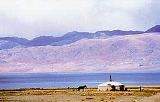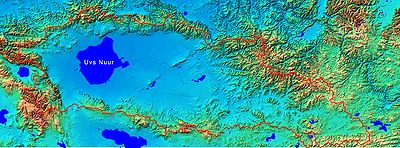
Uvs Nuur
Encyclopedia
Uvs Lake is a highly saline
lake in an endorheic basin - Uvs Nuur Basin in Mongolia
with a small part in Russia
. It is the largest lake in Mongolia by surface area, covering 3,350 km² at 759 m above sea level.
The northeastern tip of the lake is situated in the Tuva Republic of the Russian Federation
. The largest settlement near the lake is Ulaangom
. This shallow and very saline
body of water is a remainder of a huge saline sea
which covered a much larger area several thousand years ago.
by the Khan Khökhii ridge. However, it is not a rift lake as some mistakenly think.
The main feeding rivers are the Baruunturuun
, Nariin gol, and Tes from Khangai Mountains in the east, and the Kharkhiraa River and Sangil gol from the Altai Mountains in the west.
The lake freezes over from October to May. In summer, it exhibits a temperature gradient from 25°C at the surface to 19°C at the bottom.
29 different species of fish have been counted in Uvs Lake, one of them (Potanini altai osman Oreoleuciscus potanini)
is suitable for human consumption.
n biome
.
landscapes of Eurasia
. The border between Mongolia and Russia runs through the northern periphery of the basin. Here the world's most northern desert meets the world's most southern tundra
zone. Apart from the Uvs Lake, the basin
comprises several smaller lakes. As these lakes lie to the north of other inland seas of Central Asia
, they are of key importance for waterfowl
migration.
 Since the basin spans the geoclimatic boundary between Siberia
Since the basin spans the geoclimatic boundary between Siberia
and Central Asia
, temperatures may vary from −58°C in winter to 47°C in summer. Despite its harsh climate, the depression is home to 173 bird species and 41 mammal species, including the globally endangered snow leopard
, argali
, and Asiatic ibex. The population density is low here. The lack of industry and the reliance of the inhabitants on traditional ways such as nomadic pasturing have little impact on the landscape and allow the ecosystem to remain relatively pristine.
In 2003, the UNESCO listed the Uvs Lake Basin as a natural World Heritage Site
. It was nominated as "one of the largest intact watersheds in Central Asia where 40,000 archeological sites can be found from historically famous nomadic tribes such as the Scythians, the Turks
and the Huns
." This transboundary patrimony is one of the largest sites inscribed in the World Heritage List to date.
Saline water
Saline water is a general term for water that contains a significant concentration of dissolved salts . The concentration is usually expressed in parts per million of salt....
lake in an endorheic basin - Uvs Nuur Basin in Mongolia
Mongolia
Mongolia is a landlocked country in East and Central Asia. It is bordered by Russia to the north and China to the south, east and west. Although Mongolia does not share a border with Kazakhstan, its western-most point is only from Kazakhstan's eastern tip. Ulan Bator, the capital and largest...
with a small part in Russia
Russia
Russia or , officially known as both Russia and the Russian Federation , is a country in northern Eurasia. It is a federal semi-presidential republic, comprising 83 federal subjects...
. It is the largest lake in Mongolia by surface area, covering 3,350 km² at 759 m above sea level.
The northeastern tip of the lake is situated in the Tuva Republic of the Russian Federation
Russia
Russia or , officially known as both Russia and the Russian Federation , is a country in northern Eurasia. It is a federal semi-presidential republic, comprising 83 federal subjects...
. The largest settlement near the lake is Ulaangom
Ulaangom
Ulaangom is the capital of Uvs Province in Mongolia. It is located 26 km South-West from the lake Uvs Nuur shore and on the slopes of the Kharkhiraa mountain, 120 km South to the Russian border.- Description :...
. This shallow and very saline
Salinity
Salinity is the saltiness or dissolved salt content of a body of water. It is a general term used to describe the levels of different salts such as sodium chloride, magnesium and calcium sulfates, and bicarbonates...
body of water is a remainder of a huge saline sea
Sea
A sea generally refers to a large body of salt water, but the term is used in other contexts as well. Most commonly, it means a large expanse of saline water connected with an ocean, and is commonly used as a synonym for ocean...
which covered a much larger area several thousand years ago.
Geography
Uvs Lake has a length of 84 km and a width of 79 km, with an average depth of 6 m. Its basin is separated from the rest of the Great Lakes DepressionGreat Lakes Depression
The Great Lakes Depression is a large semi-arid depression in Mongolia that covers parts of the Uvs, Khovd, Zavkhan and Govi-Altai aimags. Bounded by the Altai in the West, Khangai in the East and Tannu-Ola Mountains in the North,...
by the Khan Khökhii ridge. However, it is not a rift lake as some mistakenly think.
The main feeding rivers are the Baruunturuun
Turuun River
The Turuun River is a river of western Mongolia. It flows through the sum of Baruunturuun in Uvs Province....
, Nariin gol, and Tes from Khangai Mountains in the east, and the Kharkhiraa River and Sangil gol from the Altai Mountains in the west.
Ecology
The very large catchment area with no exit results in highly saline water (18.8 ppt, one half as salty as the oceans), primarily due to sulphate and sodium ions.The lake freezes over from October to May. In summer, it exhibits a temperature gradient from 25°C at the surface to 19°C at the bottom.
29 different species of fish have been counted in Uvs Lake, one of them (Potanini altai osman Oreoleuciscus potanini)
is suitable for human consumption.
Protected sites
All of the lake and many parts of its surroundings have been declared protected sites. The UNESCO is using the designation "Uvs Lake site" as an umbrella term to summarize twelve separate clusters of protected sites, each a representative of a major eastern EurasiaEurasia
Eurasia is a continent or supercontinent comprising the traditional continents of Europe and Asia ; covering about 52,990,000 km2 or about 10.6% of the Earth's surface located primarily in the eastern and northern hemispheres...
n biome
Biome
Biomes are climatically and geographically defined as similar climatic conditions on the Earth, such as communities of plants, animals, and soil organisms, and are often referred to as ecosystems. Some parts of the earth have more or less the same kind of abiotic and biotic factors spread over a...
.
Lake Uvs Basin
The Uvs Lake is the terminal basin for the Uvs Lake Basin, which covers an area of 70,000 km² and represents one of the best-preserved natural steppeSteppe
In physical geography, steppe is an ecoregion, in the montane grasslands and shrublands and temperate grasslands, savannas, and shrublands biomes, characterized by grassland plains without trees apart from those near rivers and lakes...
landscapes of Eurasia
Eurasia
Eurasia is a continent or supercontinent comprising the traditional continents of Europe and Asia ; covering about 52,990,000 km2 or about 10.6% of the Earth's surface located primarily in the eastern and northern hemispheres...
. The border between Mongolia and Russia runs through the northern periphery of the basin. Here the world's most northern desert meets the world's most southern tundra
Tundra
In physical geography, tundra is a biome where the tree growth is hindered by low temperatures and short growing seasons. The term tundra comes through Russian тундра from the Kildin Sami word tūndâr "uplands," "treeless mountain tract." There are three types of tundra: Arctic tundra, alpine...
zone. Apart from the Uvs Lake, the basin
Drainage basin
A drainage basin is an extent or an area of land where surface water from rain and melting snow or ice converges to a single point, usually the exit of the basin, where the waters join another waterbody, such as a river, lake, reservoir, estuary, wetland, sea, or ocean...
comprises several smaller lakes. As these lakes lie to the north of other inland seas of Central Asia
Central Asia
Central Asia is a core region of the Asian continent from the Caspian Sea in the west, China in the east, Afghanistan in the south, and Russia in the north...
, they are of key importance for waterfowl
Waterfowl
Waterfowl are certain wildfowl of the order Anseriformes, especially members of the family Anatidae, which includes ducks, geese, and swans....
migration.

Siberia
Siberia is an extensive region constituting almost all of Northern Asia. Comprising the central and eastern portion of the Russian Federation, it was part of the Soviet Union from its beginning, as its predecessor states, the Tsardom of Russia and the Russian Empire, conquered it during the 16th...
and Central Asia
Central Asia
Central Asia is a core region of the Asian continent from the Caspian Sea in the west, China in the east, Afghanistan in the south, and Russia in the north...
, temperatures may vary from −58°C in winter to 47°C in summer. Despite its harsh climate, the depression is home to 173 bird species and 41 mammal species, including the globally endangered snow leopard
Snow Leopard
The snow leopard is a moderately large cat native to the mountain ranges of South Asia and Central Asia...
, argali
Argali
The argali, or the mountain sheep is a wild sheep, which roams the highlands of Central Asia . It is the biggest wild sheep, standing at the shoulder, measuring long and weighing , with a maximum known weight of...
, and Asiatic ibex. The population density is low here. The lack of industry and the reliance of the inhabitants on traditional ways such as nomadic pasturing have little impact on the landscape and allow the ecosystem to remain relatively pristine.
In 2003, the UNESCO listed the Uvs Lake Basin as a natural World Heritage Site
World Heritage Site
A UNESCO World Heritage Site is a place that is listed by the UNESCO as of special cultural or physical significance...
. It was nominated as "one of the largest intact watersheds in Central Asia where 40,000 archeological sites can be found from historically famous nomadic tribes such as the Scythians, the Turks
Turkish people
Turkish people, also known as the "Turks" , are an ethnic group primarily living in Turkey and in the former lands of the Ottoman Empire where Turkish minorities had been established in Bulgaria, Cyprus, Bosnia and Herzegovina, Georgia, Greece, Kosovo, Macedonia, and Romania...
and the Huns
Huns
The Huns were a group of nomadic people who, appearing from east of the Volga River, migrated into Europe c. AD 370 and established the vast Hunnic Empire there. Since de Guignes linked them with the Xiongnu, who had been northern neighbours of China 300 years prior to the emergence of the Huns,...
." This transboundary patrimony is one of the largest sites inscribed in the World Heritage List to date.
External links
- UNESCO evaluation of the property
- Data summary Uvs Nuur
- Protected areas of the world Uvs Nuur Basin, Russian Federation (Tuva) & Mongolia
- Natural Heritage Protection Fund - The Uvs Nuur Basin
- Notes on the Cladoceran and Copepod Fauna of the Uvs Nuur Basin (Northwest Mongolia)
- Uvs Lake, Mongolia
- The Ubsunur Hollow State Biosphere Reserve
- Ubsu-Nur Accepted into World Network of Biosphere Reserves
- Singing Stones - The Republic of Tuva
- Ubsu Nur satellite photo
- The distribution of the vegetation in the Uvs-nuur basin and its surrounding mountain ranges
- Lake Uvs and its surrounding wetlands
- Limnological Catalog of Mongolian Lakes

